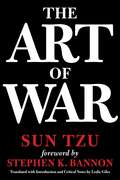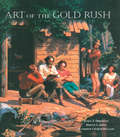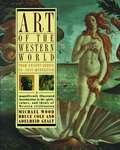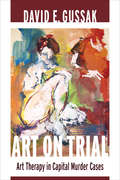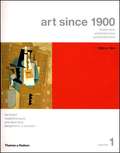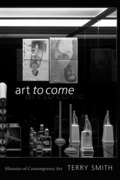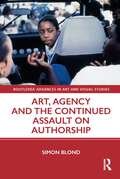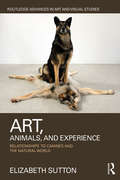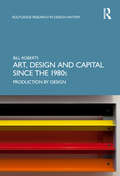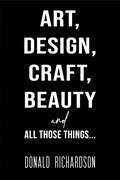- Table View
- List View
Art of Suppression: Confronting the Nazi Past in Histories of the Visual and Performing Arts (Weimar and Now: German Cultural Criticism)
by Pamela M. PotterThis provocative study asks why we have held on to vivid images of the Nazis’ total control of the visual and performing arts, even though research has shown that many artists and their works thrived under Hitler. To answer this question, Pamela M. Potter investigates how historians since 1945 have written about music, art, architecture, theater, film, and dance in Nazi Germany and how their accounts have been colored by politics of the Cold War, the fall of communism, and the wish to preserve the idea that true art and politics cannot mix. Potter maintains that although the persecution of Jewish artists and other "enemies of the state" was a high priority for the Third Reich, removing them from German cultural life did not eradicate their artistic legacies. Art of Suppression examines the cultural histories of Nazi Germany to help us understand how the circumstances of exile, the Allied occupation, the Cold War, and the complex meanings of modernism have sustained a distorted and problematic characterization of cultural life during the Third Reich.
Art of War
by Niccolo Machiavelli Christopher LynchThe purpose of this book is to provide English-speaking readers the opportunity to understand the only major prose work Machiavelli published during his lifetime- the Art of War. The book's centerpiece is a translation of the Art of War that seeks to be as faithful as possible to the original. The translation is the first to incorporate the many significant discoveries included in the recent critical edition of the Italian, edited by Jean-Jacques Marchand, Denis Fachard, and Giorgio Masi.
Art of War
by Sun Tzu&“The art of war is of vital importance to the State. It is a matter of life and death, a road either to safety or to ruin. Hence it is a subject of inquiry which can on no account be neglected.&” There is a reason why five-star generals and Fortune 500 CEOs alike have consulted this classic book on the planning and conduct of military operations. Written in China more than two thousand years ago, The Art of War is an ancient Chinese military treatise attributed to Sun Tzu, a high-ranking military general, strategist, and tactician. The Art of War remains one of the most quoted and referenced how-to books ever written. Now, with a foreword by Stephen K. Bannon, this seminal work takes on renewed significance, offering a blueprint for success amidst the chaos of contemporary challenges. As we navigate the complexities of the twenty-first century, The Art of War stands as a beacon of strategic wisdom, guiding us through the turbulent waters of life, leadership, and conflict. Its profound truths, encapsulated in thirteen timeless chapters, illuminate the path to victory in any arena, whether it be the cutthroat world of business, the arena of politics, or the theater of war.
Art of the Deal: Contemporary Art in a Global Financial Market
by Noah HorowitzArt today is defined by its relationship to money as never before. Prices have been driven to unprecedented heights, conventional boundaries within the art world have collapsed, and artists think ever more strategically about how to advance their careers. Art is no longer simply made, but packaged, sold, and branded. In Art of the Deal, Noah Horowitz exposes the inner workings of the contemporary art market, explaining how this unique economy came to be, how it works, and where it's headed.In a new postscript, Horowitz reflects on the evolution of the trade since the book's original release in 2011, shining light on the market's continued ascent as well as its most urgent challenges.
Art of the Gold Rush: (Published in association with the Oakland Museum of California and the Crocker Art Museum, Sacramento)
by Harvey L. Jones Janice T. Driesbach Katherine Church HollandThe California Gold Rush captured the get-rich dreams of people around the world more completely than almost any event in American history. This catalog, published in celebration of the sesquicentennial of the 1848 discovery of gold at Sutter's Mill, shows the vitality of the arts in the Golden State during the latter nineteenth century and documents the dramatic impact of the Gold Rush on the American imagination. Among the throngs of gold-seekers in California were artists, many self-taught, others formally trained, and their arrival produced an outpouring of artistic works that provide insights into Gold Rush events, personages, and attitudes. The best-known painting of the Gold Rush era, C.C. Nahl's Sunday Morning in the Mines (1872), was created nearly two decades after gold fever had subsided. By then the Gold Rush's mythic qualities were well established, and new allegories--particularly the American belief in the rewards of hard work and enterprise--can be seen on Nahl's canvas. Other works added to the image of California as a destination for ambitious dreamers, an image that prevails to this day. In bringing together a range of art and archival material such as artists' diaries and contemporary newspaper articles, The Art of the Gold Rush broadens our understanding of American culture during a memorable period in the nation's history.
Art of the Modern Age: Philosophy of Art from Kant to Heidegger (New French Thought Series #2)
by Jean-Marie SchaefferThis is a sweeping and provocative work of aesthetic theory: a trenchant critique of the philosophy of art as it developed from the eighteenth century to the early twentieth century, combined with a carefully reasoned plea for a new and more flexible approach to art.Jean-Marie Schaeffer, one of France's leading aestheticians, explores the writings of Kant, Schlegel, Novalis, Hegel, Schopenhauer, Nietzsche, and Heidegger to show that these diverse thinkers shared a common approach to art, which he calls the "speculative theory." According to this theory, art offers a special kind of intuitive, quasi-mystical knowledge, radically different from the rational knowledge acquired by science. This view encouraged theorists to consider artistic geniuses the high-priests of humanity, creators of works that reveal the invisible essence of the world. Philosophers came to regard inexpressibility as the aim of art, refused to consider second-tier creations genuine art, and helped to create conditions in which the genius was expected to shock, puzzle, and mystify the public. Schaeffer shows that this speculative theory helped give birth to romanticism, modernism, and the avant-garde, and paved the way for an unfortunate divorce between art and enjoyment, between "high art" and popular art, and between artists and their public.Rejecting the speculative approach, Schaeffer concludes by defending a more tolerant theory of art that gives pleasure its due, includes popular art, tolerates less successful works, and accounts for personal tastes."[A] remarkable work.... [Schaeffer's] writing is governed by ... the ideals of clarity and consequence, the ideas of logic, truth, and evidence.... Schaeffer is so precise and unrelenting a philosophical critic that one wonders how some of the philosophies he anatomizes here can possibly survive the operation."--From the foreword by Arthur C. Danto
Art of the Non-Western World: Asia, Africa, Oceania, and the Americas
by Nancy L. KelkerArt of the Non-Western World: Asia, Africa, Oceania, and the Americas gives students the tools to better understand and appreciate the arts in a global world. It offers an in-depth, contextual exploration of the art from the larger world beyond the European tradition, including painting, sculpture, pottery, graphic arts, and architecture of Asia, the Americas, Africa, Australia, and the Pacific Islands, from the Neolithic to the Contemporary. All new print and electronic versions of Art of the Non-Western World come with access to a full suite of engaging digital learning tools.
Art of the Western Saddle: A Celebration Of Style And Embellishment
by Bill ReynoldsWinner of the American Horse Publication's Best Equine Book Award of the Year (2004) Finalist for the 2005 Ben Franklin AwardSpanning time and technique, THE ART OF THE WESTERN SADDLE is a celebration and visual feast of the graceful artistry of the western saddler and his craft. Filled with detailed photographs and illustrations, this book celebrates the saddle as a decorative hallmark of subtle beauty while fulfilling the utility of its principal purpose. The ability for early man to domesticate and ride the horse created the rapid advancement of man's capability to travel and explore. The saddle-the epitome of form following function-evolved to meet the utilitarian needs of the rider and his tasks, be they work or pleasure. Illustrated with historic and contemporary examples of saddle style and decoration, THE ART OF THE WESTERN SADDLE highlights the work of makers such as Visalia Stock Saddle Company, Meana, Miles City Saddlery, Porter, Hamley, Edward H. Bohlin, McCabes, and Keyston Bros., along with contemporary makers such as Chas Weldon, Dale Harwood, Chuck Stormes, Don Butler, Chuck Treon, Jeremiah Watt, and many others. Many saddles of the stars are featured from the golden age of the Hollywood Western; these include outfits belonging to the Lone Ranger, Roy Rogers, Gene Autry, Barbara Stanwyck, Ken Maynard, and Buck Jones. THE ART OF THE WESTERN SADDLE also provides a look at the many exquisite and unpublished examples of the finest in silver and gold overlay and filigree saddle silver created by the West's preeminent metalsmiths. Featuring 300 photographs, this volume is an absolute must for all equestrians, as well as for collectors and admirers of this unique and totally American craft.
Art of the Western World: From Ancient Greece to Post-Modernism
by Bruce Cole Adelheid GealtA good know-how book to gather information about Art progression through the centuries and periods - right from its classical roots in Greece until present day.
Art on Trial: Art Therapy in Capital Murder Cases
by David GussakA man kidnaps his two children, murders one, and attempts to kill the other. The prosecution seeks the death penalty, while the defense employs an unusual strategy to avoid the sentence. The defendant's attorneys turn to more than 100 examples of his artwork, created over many years, to determine whether he was mentally ill at the time he committed the crimes. Detailing an outstanding example of the use of forensic art therapy in a capital murder case, David Gussak, an art therapist contracted by the defense to analyze the images that were to be presented as evidence, recounts his findings and his testimony in court, as well as the future implications of his work for criminal proceedings. <P><P>Gussak describes the role of the art therapist as an expert witness in a murder case, the way to use art as evidence, and the conclusions and assessments that professionals can draw from a defendant's artworks. He examines the effectiveness of expert testimony as communicated by the prosecution, defense, and court, and weighs the moral, ethical, and legal consequences of relying on such evidence. For professionals and general readers, this gripping volume presents a convincing account of the ability of art to reflect a damaged and dangerous psyche. A leading text on an emerging field, Art on Trial demonstrates the practical applications of an innovative approach to clinical assessment and treatment.
Art on the Block: Tracking the New York Art World from SoHo to the Bowery, Bushwick and Beyond
by Ann FensterstockA fascinating tour of the last five decades of contemporary art in New York City, showing how artists are catalysts of gentrification and how neighborhoods in turn shape their art--with special insights into the work of artists such as Jean-Michel Basquiat, Cindy Sherman, and Jeff KoonsStories of New York City's fabled art scene conjure up artists' lofts in SoHo, studios in Brooklyn, and block after block of galleries in Chelsea. But today, no artist can afford a SoHo loft, Brooklyn has long gentrified, and even the galleries of Chelsea are beginning to move on. Art on the Block takes the reader on a journey through the neighborhoods that shape, and are shaped by, New York's ever-evolving art world. Based on interviews with over 150 gallery directors, as well as the artists themselves, art historian and cultural commentator Ann Fensterstock explores the genesis, expansion, maturation and ultimate restless migration of the New York art world from one initially undiscovered neighborhood to the next.Opening with the colonization of the desolate South Houston Industrial District in the late 1960s, the book follows the art world's subsequent elopements to the East Village in the ‘80s, Brooklyn in the mid-90s, Chelsea at the beginning of the new millennium and, most recently, to the Lower East Side. With a look to the newest neighborhoods that artists are just now beginning to occupy, this is a must-read for both art enthusiasts as well as anyone with a passion for New York City.
Art on the Line: Essays by Artists About the Point Where Their Art & Activism Intersect
by Jack HirschmanArt on the Line is a collection of essays by writers and artists speaking about where their social commitment and their art intersect. These essays illuminate the aesthetics of "engaged art," and include work by artists from Latin America, Europe, Asia, Africa, and the United States. These socially-engaged artists write about art that moves people to action as well as pleasure, writing about the function of the arts, in the tradition of artists like Bertolt Brecht, Kathe Kollwitz, and Richard Wright.
Art or Scribbles? In the Eye of the Beholder: The Evolutionary Emergence of Visual Communication (Interdisciplinary Evolution Research #11)
by Iain DavidsonThe book is about how art arose; and how it became what we call art today. How did art emerge from the relationships between people and the things they produce and the ideas of producers? How do people manipulate those relationships in their own society? How do outsiders work out the ways in which those relationships were used to make art? What is art and why are all people engaged with it in one way or another? From its very beginning, and everywhere, art has always been embedded in its cultural context—the contexts of the people who made and see it—and that context has often been ritual. The history of art confused &“social and institutional changes&” of view because western critics (or artists) sought to define the boundaries of art so tightly that ritual, purposeful or utilitarian works were excluded from it. In their definition, art only existed if the rituals of the original producers were stripped from the works or if the objects were appropriated away from the situation in which they were produced. The objects stripped from their context could then only be valued for their aesthetics. Art consists of relationships between people, things, and ideas in quite specific ways. Those relationships are discussed at length in this book. The book is aimed at artists, art historians and archaeologists, but also at the general public interested in art. It is intended both for people whose interest in art comes from knowledge of the art of all continents, and for those who have no knowledge.
Art since 1900: Modernism, Antimodernism, Postmodernism (Volume 1, 1900-1944)
by Hal Foster Yve-Alain Bois Benjamin H. D. Buchloh Rosalind E. KraussIn this groundbreaking and original work of scholarship, four of the most influential and provocative art historians of our time have come together to provide a comprehensive history of art in the twentieth century, an age when artists in the United States, Europe, and elsewhere sought to overturn the traditions of the past and expectations of the present in order to invent new practices and forms. Adopting a unique year-by-year approach, Foster, Krauss, Bois, and Buchloh present more than 50 short essays, each focusing on a crucial event the creation of a seminal work, the publication of an artistic manifesto, the opening of a major exhibition to tell the story of the dazzling diversity of practice and interpretation that characterizes the art of the period. All the turning points and breakthroughs of modernism and postmodernism are explored in depth, as are the frequent and sustained antimodernist reactions that proposed alternative visions of art and the world. Illustrating the authors' texts are more than 300 of the most important works of the century, many reproduced in full color. The book's flexible structure and extensive cross-referencing allow readers to follow any one of the many narratives that unfold, whether that be the history of a medium such as photography or painting, the development of art in a particular country, the influence of a movement such as surrealism or feminism, or the emergence of a stylistic or conceptual category like abstraction or minimalism. Boxes give further background information on the important figures and issues. In their insightful introductions, the four authors explain the different methods of art history at work in the book, providing the reader with the conceptual tools for further study. A roundtable discussion at the close of the book considers the questions raised by the preceding decades and look ahead to the art of the future. A glossary of terms and concepts completes this extraordinary volume.
Art since 1900: Modernism, Antimodernism, Postmodernism (Volume 2, 1945-Present)
by Hal Foster Yve-Alain Bois Benjamin H. D. Buchloh Rosalind E. KraussIn this groundbreaking and original work of scholarship, four of the most influential and provocative art historians of our time have come together to provide a comprehensive history of art in the twentieth century, an age when artists in the United States, Europe, and elsewhere sought to overturn the traditions of the past and expectations of the present in order to invent new practices and forms. Adopting a unique year-by-year approach, Foster, Krauss, Bois, and Buchloh present more than 100 short essays, each focusing on a crucial event the creation of a seminal work, the publication of an artistic manifesto, the opening of a major exhibition to tell the story of the dazzling diversity of practice and interpretation that characterizes the art of the period. All the turning points and breakthroughs of modernism and postmodernism are explored in depth, as are the frequent and sustained antimodernist reactions that proposed alternative visions of art and the world. Illustrating the authors' texts are more than 600 of the most important works of the century, many reproduced in full color. The book's flexible structure and extensive cross-referencing allow readers to follow any one of the many narratives that unfold, whether that be the history of a medium such as photography or painting, the development of art in a particular country, the influence of a movement such as surrealism or feminism, or the emergence of a stylistic or conceptual category like abstraction or minimalism. Boxes give further background information on the important figures and issues. In their insightful introductions, the four authors explain the different methods of art history at work in the book, providing the reader with the conceptual tools for further study. Two roundtable discussions one at midcentury, the other at the close of the book consider the questions raised by the preceding decades and look ahead to the art of the future. A glossary of terms and concepts completes this extraordinary volume.
Art since 1940
by Jonathan David FinebergThis comprehensive and authoritative textbook illustrates art from the 1940's and stresses the individuality of the artists in relation to their political, social, and cultural contexts. The book focuses on the meaning of the major works and innovations. It features nearly 600 illustrations (approximately half in color) representing art since 1940, both in Europe and America. It explores the full range of periods, artists, and movements: New York in the Forties; Calder, Hofmann, Gorky, Motherwell, De Kooning; Existentialism (Pollock, Newman, Rothko, David Smith); The New European Masters of the Late Forties (Dubuffet, Giacometti, Bacon), plus so much more. For anyone interested in Postwar Art.
Art to Come: Histories of Contemporary Art
by Terry SmithIn Art to Come Terry Smith—who is widely recognized as one of the world's leading historians and theorists of contemporary art—traces the emergence of contemporary art and further develops his concept of contemporaneity. Smith shows that embracing contemporaneity as both a historical concept and a condition of the globalized world allows us to grasp how contemporary art exists in a fluid space of increasing interdependencies, multiple contemporaneous modernities, and persistent inequalities. Throughout these essays, Smith offers systematic proposals for writing contemporary art's histories while assessing how curators, critics, philosophers, artists, and art historians are currently doing so. Among other topics, Smith examines the intersection of architecture with other visual arts, Chinese art since the Cultural Revolution, how philosophers are theorizing concepts associated with the contemporary, Australian Indigenous art, and the current state of art history. Art to Come will be essential reading for artists, art students, curators, gallery workers, historians, critics, and theorists.
Art, Agency and the Continued Assault on Authorship (Routledge Advances in Art and Visual Studies)
by Simon BlondThis book presents a counter-history to the relentless critique of the humanist subject and authorial agency that has taken place over the past fifty years. It is both an interrogation of that critique and the tracing of an alternative narrative from Romanticism to the twenty-first century which celebrates the agency of the artist as a powerful contribution to the wellbeing of the community. It does so through arguments based on philosophical aesthetics and cultural theory interspersed with case histories of particular artists. It also engages with a second issue that cannot be separated from the first. This is the question of what the role and purpose of art is in society. This has become particularly important since the 1990s because of the "social turn" in art in which it is claimed that the only valid role for art was one that had explicit social consequences. This book argues that a political role for art is valuable, but not the only one that can be envisaged nor indeed is it the most obvious or most important. Art has other social roles both as a means to engender empathy and community, and to re-enchant a world bereft of meaning and reduced to material values. The book will appeal to practising artists as well as scholars working in art history, philosophy, aesthetics, and curatorial studies.
Art, Animals, and Experience: Relationships to Canines and the Natural World (Routledge Advances in Art and Visual Studies)
by Elizabeth SuttonElizabeth Sutton, using a phenomenological approach, investigates how animals in art invite viewers to contemplate human relationships to the natural world. Using Rembrandt van Rijn’s etching of The Presentation in the Temple (c. 1640), Joseph Beuys’s social sculpture I Like America and America Likes Me (1974), archaic rock paintings at Horseshoe Canyon, Canyonlands National Park, and examples from contemporary art, this book demonstrates how artists across time and cultures employed animals to draw attention to the sensory experience of the composition and reflect upon the shared sensory awareness of the world.
Art, Annotated: The World's 500 Greatest Paintings Explained
by DKA stunning art gallery in a book, art, annotated spans more than 3,000 years of paintings, sculptures, and prints.Combining reproductions of each work of art with precise annotations and visual analysis, it is an expertly curated selection of the finest art ever created.Immerse yourself in this book and learn all about art - how Michelangelo painted nudes, what cubism is, and where abstraction came from. Discover ancient Egyptian frescoes, read the visual clues to Leonardo da Vinci's Last Supper, and find out what inspired Louise Bourgeois and Banksy.In this art book, you will find:Art from all over the world exploring key elements such as composition, color, technique, and symbolism.Profiles the work of more than 450 artists from across the world and many different cultures, covering every period and major art movement.Art set in its historical context, which makes art, annotated a complete overview of art history.An optional 32-page directory of biographies of all the artists featured at the back of the book.Packed with information and full of inspiration, art, annotated brings the finest paintings and sculptures right into your home. It is the ultimate history of art and visual sourcebook for all art lovers.
Art, Artefacts and Chronology in Classical Archaeology (Approaching the Ancient World)
by William R. BiersThe museums of the world are full of statues and other artefacts of the Greeks and the Romans. All are given a date. But how are these dates arrived at. What is the evidence?This study provides the student with an introduction and explanation of the ways scholars date the archaeological remains of classical antiquity. Specific examples from architecture, sculpture, and painting are presented, and the differnt methods of dating them are explained. These are supplemented with many original photographs and drawings. Old, and not so old problems in chronology are thus investigated and new theories reviewed from a fresh perspective.
Art, Creativity, and Politics in Africa and the Diaspora (African Histories and Modernities)
by Toyin Falola Abimbola AdelakunThis book explores the politics of artistic creativity, examining how black artists in Africa and the diaspora create art as a procedure of self-making. Essays cross continents to uncover the efflorescence of black culture in national and global contexts and in literature, film, performance, music, and visual art. Contributors place the concerns of black artists and their works within national and transnational conversations on anti-black racism, xenophobia, ethnocentrism, migration, resettlement, resistance, and transnational feminisms. Does art by the subaltern fulfill the liberatory potential that critics have ascribed to it? What other possibilities does political art offer? Together, these essays sort through the aesthetics of daily life to build a thesis that reflects the desire of black artists and cultures to remake themselves and their world.
Art, Cybernetics and Pedagogy in Post-War Britain: Roy Ascott’s Groundcourse (Routledge Advances in Art and Visual Studies)
by Kate SloanThis is the first full-length study about the British artist Roy Ascott, one of the first cybernetic artists, with a career spanning seven decades to date. The book focuses on his early career, exploring the evolution of his early interests in communication in the context of the rich overlaps between art, science and engineering in Britain during the 1950s and 1960s. The first part of the book looks at Ascott’s training and early work. The second park looks solely at Groundcourse, Ascott’s extraordinary pedagogical model for visual arts and cybernetics which used an integrative and systems-based model, drawing in behaviourism, analogue machines, performance and games. Using hitherto unpublished photographs and documents, this book will establish a more prominent place for cybernetics in post-war British art.
Art, Design and Capital since the 1980s: Production by Design (Routledge Research in Design History)
by Bill RobertsThis book examines artists’ engagements with design and architecture since the 1980s, and asks what they reveal about contemporary capitalist production and social life. Setting recent practices in historical relief, and exploring the work of Dan Graham, Rita McBride, Tobias Rehberger and Liam Gillick, Bill Roberts argues that design is a singularly valuable lens through which artists evoke, trace and critique the forces and relations of production that underpin everyday experience in advanced capitalist economies.
Art, Design, Craft, Beauty and All Those Things…
by Donald RichardsonResponding to many recent calls for redress and restitution, Richardson summarises the historical and current situation and attributes its problematics to the fact that theorists and historians have taken the concept art as a generic that includes both design and craft – which are actually and validly distinguishable from art by application of the concept function/al – or else ignored the two entirely. Considering the concept function/al, he maintains, calls into question the view that the three may be sub-classes of the one class: whereas in a work of art, typically there is a resolution of the tension between form and content, in works of design and craft the resolution is between form and function. How this recognition can clarify the issue informs the entire book. The book’s other major thesis is the realisation that aesthetic values are inherently human and that, therefore, they apply not only to art but to life in general. Far from being frivolous or a mere ‘emotion’, the aesthetic is a sense of equivalent psychic status to sight and hearing and, like them, is employed at almost every moment of our daily lives – which fact grounds art, design and craft deeply in human life. This is reflected in the universal use of the human form (including the exhibition of sexual characteristics) in art. The eternal conflict between making art and making a living from making art is examined and contrasted to the rarely-recognised, but positive, role of design in planning and industry. Richardson also critiques common theories of representation and composition, including ‘creativity’, Albertian perspective and scientific and geometric theories of beauty and composition; also the relevance of the camera and the computer in the field.


